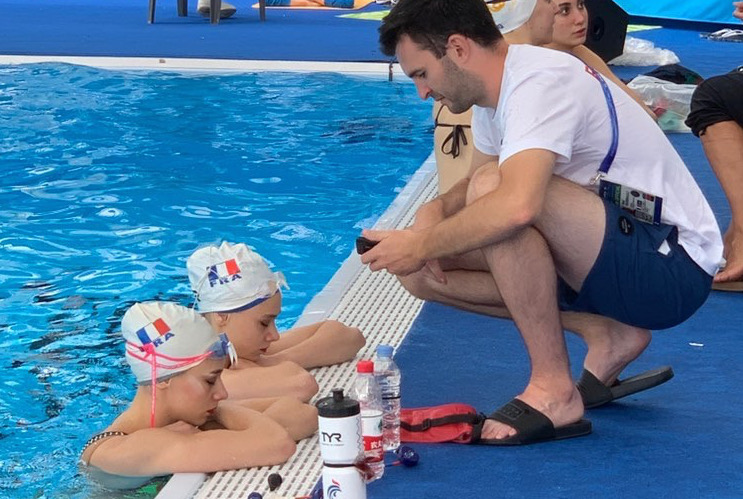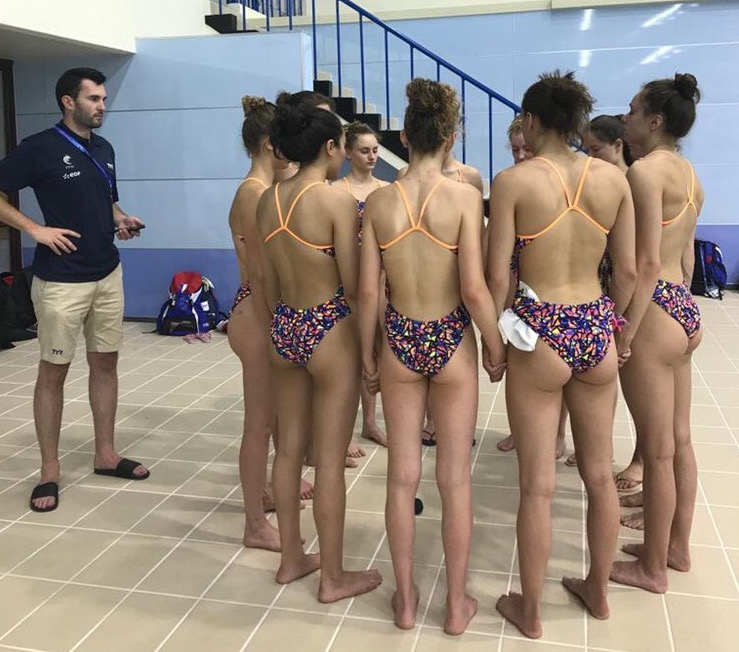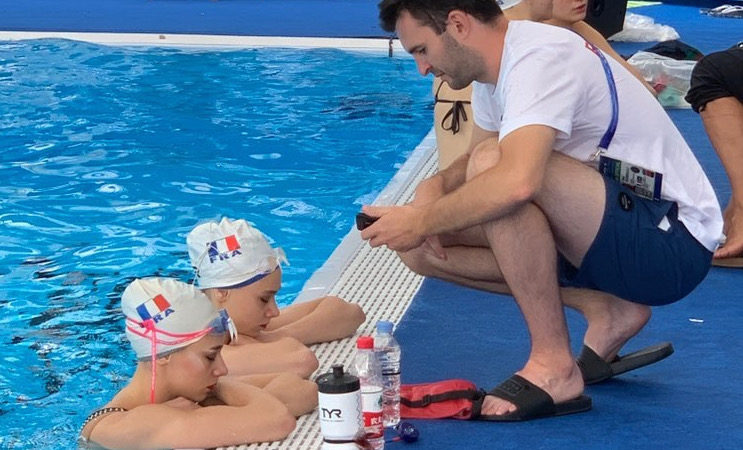Maël Goisbault became the French national team’s sports psychologist ahead of the 2019 season.
While working with handball and basketball teams during the course of his masters degree on performance optimization and mental preparation, he met and sought out the advice of Julie Doron, then-researcher at the INSEP (the National Institute of Sport, Expertise, and Performance). Incidentally, Doron worked with the artistic swimming team the year before Goisbault’s arrival, and eventually recommended him to the French swimming federation as it implemented a new sports psychology program for all of its aquatics discipline.
Inside Synchro spoke with Goisbault as the French artistic swimming was in lockdown during the COVID-19 pandemic to discuss his role within the team, what his work revolves around in training and during competitions, as well as his insight regarding the situation and the major changes that the athletes have had to handle these last few months.

Inside Synchro: Did you know a little bit about artistic swimming before starting to work with the team?
Maël Goisbault: Not at all. I came in with my own preconceptions on the sport but they were rapidly shattered. I was really stunned by the sport itself, but also by its demands and every facet of it. I had never worked with an artistic sport before. This year I witnessed the creation of the new free team routine and I have to admit I found it all incredible. This creative process and everything that goes with it is something that I’ve never seen in any other sport. It also fascinated me to see artistic swimming in terms of its technical demands and interpersonal coordination. It really is a very complete and hyper demanding sport, and I have been left wondering which other sports have such high demands.
IS: What kind of preconceptions did you have?
MG: I actually come from an equestrian background, so I was sort of comparing the two in my head. I expected to find something like dressage where everything is very codified and very conservative. I started working with the team at the French Open, and just hearing all the different music and seeing the atmosphere in the stands made me realize that these two sports had absolutely nothing in common. It’s this diversity in all the music used that really surprised me at first. Realistically, I didn’t really understand everything on the artistic impression and technical difficulty, even now, but this diversity in innovation, in music, in choreographies, is what shocked me the most and really ended that comparison I had in my mind with dressage.
IS: In “regular” times, how often do you work with the team and what’s your exact role?
MG: I usually attend two training sessions per week, and on top of that we will have a group session, where it will be more about reflections, discussions and “theory” if I can say. At first, I was actually working more on an individual basis, with individual themes and dimensions, like management of emotions or concentration. Then we moved on to collective work and it was more about the values within the group. We worked on interactions and on everything that had to do with the feeling of collective efficiency, like the belief that we will succeed. So, this was all last year between March and [the world championships in] Gwangju.
This year, I started off again with more individual work while also holding more group sessions. Last year I did one and then the other, but this year I am trying to juggle both at the same time. It allows for a fairly complete intervention that meets the needs of the swimmers and coaches.
IS: So if or when the athletes need you, they can call you up for an individual session?
MG: Yes. I work mainly on group sessions now, and within those we discuss individual dimensions, like emotions management for example, and the athletes themselves can share their own strategies that they then can implement individually or with the group. Of course, I regularly have individual sessions with swimmers to deal with more specific and more personal problems, but that’s not the majority of my work. That’s going to be more on an ‘on-demand’ basis, or if I see that there is a topic that has to be addressed, then I will solicit a swimmer individually, but it is really more infrequent.
IS: You are also alongside the team during competitions. Do you have a very active role there, or has most of the work been done beforehand?
MG: That’s a good question. I think that most of the work is done beforehand. Really, if I only came to competitions without also being involved at INSEP with the group in training, I think that my place in competitions would be more precarious. Or, I suppose I wouldn’t be of much use. Having that upstream preparation makes it possible to implement things in the competitive setting, and to easily connect the work that has been done at INSEP in a less intense environment. I will help them in that pressure setting where they won’t necessarily identify the strategies by themselves that we have talked about or implemented in the past. I’m really there to recontextualize the work that we did beforehand in that competitive setting. I think the two are really complementary.
IS: I believe it is quite unique for a team to have its sports psychologist present on the side of the pool at competitions.
MG: Yes, and it gives another dimension to work. I am on the poolside with them and not just in an office where I see the swimmers one by one by appointment only. There is a regular contact with the coaches, and for me being right there “in the field” with them is in my mind essential for my work to have an impact.
IS: Was this all implemented before you got there?
MG: Not quite. Within the INSEP, the girls could ask for a sports psychologist but it was not a systematic intervention. They had worked with Julie Doron but it was not as regular as it is now. In fact, I really am designated as the team’s mental coach. I am made available to the group and they know it. There is regular contact, so it’s not just according to needs or only when they need me. They see me every week regardless, whether on the side of the pool or in a group session.
IS: You were talking about the work you do before the competition itself. What types of exercises or tools do you like to implement?
MG: We can use different tools. I like to work with a psychotherapy approach called “Acceptance and Commitment Therapy,” and it’s based on the concept of psychological flexibility. I’m not going to go into it too much but basically there are three big dimensions. The first one is, am I open? Am I open to my thoughts, to my emotions, to other ways of thinking? It’s all about seeing the alternatives in the situations I live and my way of projecting myself too. Then, am I centered? Am I centered in the present moment, or centered in a specific context too? For example, athletes who have been injured for a long period and who seek to return to their previous level are no longer centered in the current situation but rather on what happened before. So, I try to guide their focus back to that specific context. And third, am I committed? There, we have to clearly identify goals and also the actions that we have to associate with that.
In terms of tools, I work a lot on mindfulness and how to manage their thoughts. Here again I have three different ways to look at it, where I first help them focus on experiencing the present moment. Then, we are going to identify the thoughts that can cross their minds, really look at them, and distance ourselves from them. Finally, I will try to have them refocus on their breathing, or on their feelings in the context of the performance. For example, that might be about the execution they want to achieve in a routine.
IS: And for the team itself?
MG: There is also some goal-setting as well. I really like to work around the concept of collective resilience. In fact here, we are going to have four different aspects to consider. First, we have to look at the structure of the group itself and everything that has to do with standards and values. The second is all about that feeling of collective efficiency, and therefore confidence in the group and in its ability to succeed. The third angle is going to be the social capital, so I will look at all the interactions within the group and make sure they are productive and optimal for performance. And finally, the last one is about what the group can master and if it is able to reach a perspective of learning, developing, and progressing in the training so as to evolve and build something together.

IS: Now that you’ve been with the team for more than a year, what is the biggest challenge in artistic swimming from your perspective?
MG: I think that the management of concentration is super important, not so much in competition but in training because the training sessions are so long. Over the course of a session, it will happen progressively where we will lose quality in terms of concentration, and as a result in technical and skill quality. It was important to work on that first to maintain a high level of concentration throughout the entire session. I helped each swimmer manage their concentration and identify the moments when there are distractions that come to interfere with their commitment to training, and thus helped them refocus during those moments. It was quite important, and that’s really what I was recruited for in the first place.
IS: Have you observed any changes or improvements during this past year, or have other problems surfaced?
MG: It’s hard to answer that (laughs)! I suppose that yes, there have been good changes. Well, I hope that the girls have turned a corner regarding their concentration. I also feel they have improved in terms of managing their emotions, in accepting them, and doing so within the uncertainty of a competition, particularly with everything that can occur around them that they do not control. They have to accept that. I also really think that we’ve hit a milestone in the last year in terms of performance level. It went pretty quickly at the start, as I had good feedback from the coaches who noticed it fast enough, and then all that work manifested itself in competitions fairly quickly as well.
IS: During the lockdown [which lasted from March 16 to May 11 in France], how did you manage this peculiar situation with the team, and did you implement anything new?
MG: Of course, everything was flipped upside down. But I think we reorganized everything really well with the staff. [Head coaches] Julie [Fabre] and Laure [Obry] were very proactive, and they acted quickly at the beginning of the lockdown to implement new things with the rest of the staff and with different consultants and speakers to really support the girls as well as possible.
The schedule itself depends on the weeks so as to not overload the girls either in such uncertain and emotionally-charged times, and where there is a whole reorganization that is done at all levels of society, and not just sports. As for me, I try to stay connected with the girls. I do a video call with each once a week, sometimes it lasts 15 minutes, sometimes 30, but it doesn’t matter as it’s just to maintain that contact, to see if everything is fine or if I need to be more present, especially knowing that this is a really delicate period.
The federation also sends all of its athletes a questionnaire once a week to assess how they feel, how they have organized themselves, and how they are managing everything. It’s really been very organized on all sides.
IS: Once the Olympic Games were officially postponed, did you feel you had to be more present to help them deal with that news?
MG: Hmm…. (he pauses). I didn’t do any specific work on it. I was just there to listen to all of them as they processed their emotions related to it. This [postponement] mostly led to a big reorganization in terms of their studies which they had originally put on hold this year, but that’s not really my responsibility at all.
This was certainly all about accepting the situation, but I think it happened naturally for them. There is a real strength in this group, and with each new challenge or new difficulty, the group itself really tightens up so I think that was the case here too. Even from a distance with the lockdown, I didn’t need to do any specific work because the group itself came together around that with the coaches.
IS: I had spoken with Laura and Charlotte Tremble at the start of the lockdown before anything was officially postponed or canceled. Charlotte said that at first she couldn’t stop thinking of the “what ifs:” what if the Games are postponed, what if our dream is pushed back, what if, what if… And she said that she had done a lot of work with you to fully accept she was not in control of anything.
MG: Yes exactly. This also all comes back to that work of acceptance that we had been doing for the last year or so. I mean, I hadn’t planned it for this lockdown specifically, or else I am scarily good (laughs)! But seriously, it allowed us to bounce back fast and to use that work in a context where it was necessary to accept the situation and all the emotions that it brings out.
In fact, I think that before the postponement of the Games, the level of stress and uncertainty was at its highest for a lot of athletes. Everyone was caught between two stools and wondering how to continue preparing and training while fully knowing there was a high likelihood that all their competitions of the year were going to get canceled, and that the competition of their lives might get canceled or pushed back too. That was very complicated. They had to accept that they had no information on this.
Once the Games were postponed, they then had to accept that everything would have to be rescheduled, reorganized, and that decisions at the higher levels would have to be made. And as long as those aren’t made, all they could do was stay centered on what they, at their level, could do, and not try to anticipate anything that may or may not happen. So yes of course, it all tied back to some of the work we had already done during last season, so that was very helpful in that sense.
IS: Finally, I know it’s hard to predict anything right now, but how do you see the future for this team?
MG: Clearly there are a lot of decisions that still have to be made over which we have no control. As long as we don’t have that, it’s a bit like torturing ourselves if we’re trying to anticipate how the rest of the year will go. So, we are staying focused on what we can do now so as to be able to resume training in the best conditions. It has been all about being active so it allows them to maintain themselves physically and mentally without being overloaded either. But it’s true that it’s been a lot of “wait and see.”
This interview was conducted a few weeks ago, but at the time of publication, the French national team has learned it will be able to resume training the week on May 18, 2020, after nearly two months out of the water.
Article by Christina Marmet
If you’ve enjoyed our coverage and are looking forward to it during the 2020 offseason and the 2021 season, consider donating to Inside Synchro! Any amount helps us run the site and cover meets.

